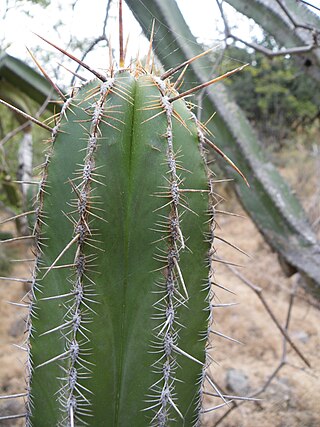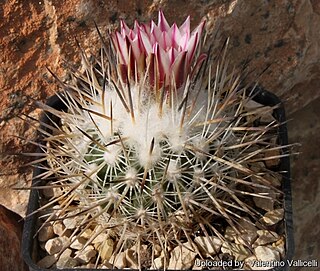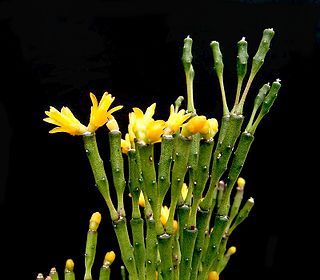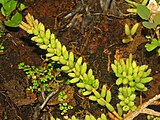
Stetsonia coryne, the toothpick cactus, is the sole species in the cactus genus Stetsonia. Stetsonia coryne grows to a height of 15 to 25 ft tall. It has white flowers.

Disocactus is a genus of epiphytic cacti in the tribe Hylocereeae found in Central America, the Caribbean and northern South America. It should not be confused with Discocactus, which is a different genus.

Escontria is a genus of cactus. The only species is Escontria chiotilla, the chiotilla or jiotilla.

Rhipsalis is a genus of epiphytic flowering plants in the cactus family, typically known as mistletoe cacti. They are found in parts of Central America, the Caribbean and northern regions of South America. They also inhabit isolated locations in Africa and Asia, and are the only cactus group naturally occurring in the Old World. This is the largest and most widely distributed genus of epiphytic cacti.

Samaipaticereus is a monotypic genus of cactus containing the sole species Samaipaticereus corroanus. It is known only from East Andean Bolivia and Peru.

Yungasocereus is a monotypic genus of cacti. Its sole species is Yungasocereus inquisivensis, native to Bolivia.

Yavia cryptocarpa is a species of cactus and the only species of the newly discovered genus Yavia. The genus is named after Argentina's department Yavi, Jujuy Province, where the plant is endemic to sparsely vegetated rocky slopes. The plant is also sometimes put in the tribe Notocacteae. The specific epithet cryptocarpa refers to the plant being a cryptocarp. This means that the fruits are formed inside the plant's body, thus being only visible when the plant shrinks in the drought period.

Rhipsalis baccifera, commonly known as the mistletoe cactus, is an epiphytic cactus which originates from Central and South America, the Caribbean, and Florida. It is also found throughout the tropics of Africa and into Sri Lanka where it is known in Sinhala as nawahandi (නවහන්දි). This is the only cactus species naturally occurring outside the Americas. One hypothesis is that it was introduced to the Old World by migratory birds, long enough ago for the Old World populations to be regarded as distinct subspecies. An alternative hypothesis holds that the species initially crossed the Atlantic Ocean on European ships trading between South America and Africa, after which birds may have spread it more widely.

Ariocarpus agavoides is a species of cactus. It is endemic to Mexico. It grows in dry shrubland in rocky calcareous substrates. Some taxonomists place it in a separate genus as Neogomezia agavoides. The locals use the slime from the roots of the plants as glue to repair pottery. The sweet-tasting warts are eaten and often added to salads

Arthrocereus melanurus is a species of plant in the family Cactaceae. It is endemic to Brazil. Its natural habitats are dry savanna and rocky areas. It is threatened largely by habitat loss.

Rhipsalis pilocarpa, the hairy-fruited wickerware cactus, is a species of flowering plant in the cactus family that is endemic to Brazil. Scarce in the wild, it is known only in a small number of isolated locations. Its status is listed as “vulnerable” by the IUCN Red List. However, it is cultivated as an ornamental houseplant and as such has gained the Royal Horticultural Society’s Award of Garden Merit.

Kadenicarpus horripilus is a species of plant in the family Cactaceae.

Rapicactus mandragora, synonym Turbinicarpus mandragora, is a species of plant in the family Cactaceae.

Kadenicarpus pseudomacrochele, synonym Turbinicarpus pseudomacrochele, is a species of plant in the family Cactaceae.

Acanthocereus tetragonus is a species of cactus that is native to Florida and the Lower Rio Grande Valley of Texas in the United States, Mexico, Central America, the Caribbean, and northern South America. The species is invasive in New Caledonia. Common names include night-blooming cereus, barbed-wire cactus, sword-pear, dildo cactus, triangle cactus, and Órgano-alado de pitaya (Spanish). The miniature cultivar is known as fairy castle cactus. It was originally described by Carl Linnaeus in 1753 as Cactus tetragonus but was moved to the genus Acanthocereus in 1938 by Pieter Wagenaar Hummelinck.

The Rhipsalideae are a small tribe of cacti, comprising four or five genera. They grow on trees (epiphytes) or on rocks (lithophytes), where they either hang down or form creeping or upright shrubs. Their flowers open in the day and remain open at night; they may be either radially symmetrical (regular) or bilaterally symmetrical (zygomorphic). The fruits are berry-like, fleshy with smallish seeds.

Pachycereus pecten-aboriginum is a columnar cactus plant native to Mexico. They can grow up to 15 m (49 ft) high. The trunk of this species is 1.2 to 5.0 m tall and the fruits are large and burr-like. The specific name, pecten-aboriginum, is from the Latin, and means "native combs". It was inspired by the use of the fruits as hair combs.

Hatiora salicornioides, the bottle cactus, dancing-bones, drunkard's-dream, or spice cactus, is a species of flowering plant in the cactus family. A member of the tribe Rhipsalideae, it often grows as an epiphyte, natively in eastern Brazil and ornamentally elsewhere.

Lobivia ancistrophora is a species of cactus. It has a globular shape, few spines, with large, white flowers attached to long, green tubes. It occurs in Bolivia, at altitudes of 600–1800 metres. Under its synonym Echinopsis ancistrophora it has gained the Royal Horticultural Society's Award of Garden Merit.
Hatiora herminiae is a species of flowering plant in the tribe Rhipsalideae, family Cactaceae. It grows as an epiphyte in cloud forests in Southeast Brazil.






















